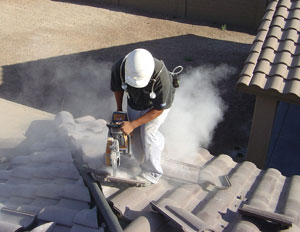
Since OSHA's inception, the number of deaths attributed to silicosis has declined to approximately 250-300 per year. Many believe the decline in silicosis deaths occurred as a result of improved controls that were implemented after OSHA was created. Many of the silicosis deaths that have occurred since OSHA's inception may have been caused by silica exposures that occurred prior to OSHA. The decline in the number of US manufacturing facilities has also been listed as a possible reason for the decline in silicosis deaths.
It should be noted that silicosis numbers may be misleading for several reasons. There may be inconsistencies in reporting on death certificates so the number of fatalities may be under-reported. In addition, there may be silicosis cases that are undiagnosed or misdiagnosed so the actual number of cases reported may be underestimated. The quality of life may be significantly reduced for those with this lung disease.
(10 mg/m3) ÷ (% silica + 2)
As the percentage of silica increases, the PEL decreases. The PEL formula essentially limits the respirable silica concentration to 0.1 mg/m3.
Since OSHA's inception in the early 70's, there has been periodic interest in establishment of a substance specific Silica standard, similar to those present for Lead, Cadmium and others in Part 1910 Subpart Z. Currently, OSHA has efforts underway to establish a substance- specific standard for Silica which contains a PEL at a fixed level of 0.1, 0.075 or 0.05 mg/m3. The draft proposal for a Silica PEL also contains specific requirements for air sampling, respirators, hygiene facilities and medical surveillance. It should be noted that those proposed requirements are not enforced as law; however, it would be wise to become familiar with those requirements
The OSHA PEL for silica in Construction is currently based upon an obsolete sampling method that counts dust particles. To protect construction workers from exposures to silica, controls should be implemented to the General Industry PEL (as a minimum) although arguments could be made that the General Industry PEL is not enforceable for the construction industry.
The MSHA PEL for respirable silica uses the same formula as the OSHA General Industry PEL listed above.
The ACGIH TLV for respirable silica-quartz is 0.025 mg/m3 for an 8-hour time-weighted average (TWA) exposure (2007). Since 1974, the NIOSH REL for crystalline silica has been 0.05 mg/m3.